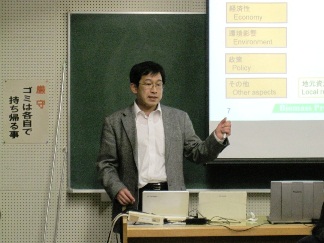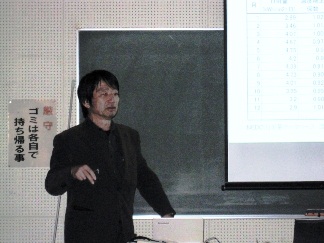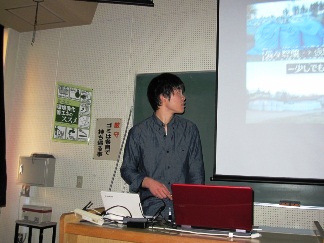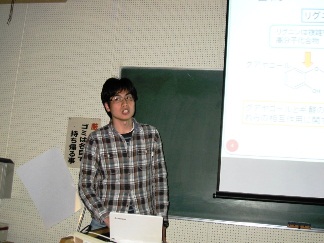On Apr 23, 2014, the 19th Biomass Evening Seminar was held at Graduate School of Engineering, Hiroshima University.
Biomass Project Research Center, Hiroshima University, and HOSTY Association are co-organizing the Hiroshima University Biomass Evening Seminar. This seminar covers topics from the fundamentals of biomass to the latest information so that it can contribute the activities on biomass in this district.
- Date & Time: Wed., Apr.23, 2014 16:20 - 17:50
- Place:
Engineering 110 Lecture Room, Higashi-Hiroshima Campus, Hiroshima University
[Program]
- Commentary:
Yukihiko MATSUMURA
Professor, Institute of Engineering, Hiroshima University

- Chair:
Machi KANNA
Assistant Professor, Institute of Engineering, Hiroshima University
- Lecture:
Takaharu SATOU
Associate Professor, Graduate School of Integrated Arts and Sciences, Hiroshima University
"Attempt of woody biomass dissemination aimed at energy autonomy in Higashihiroshima"
|
In order to promote energy autonomy in Higashihiroshima, it is necessary to spread renewable energy suitable for Higashihiroshima and to reduce the total energy consumption promoting the energy saving. Review the possibility of woody biomass, a renewable energy suitable for Higashi-Hiroshima, we introduce an attempt to aim at the expansion. |
 |
- Lecture:
Daisuke NIKI
M1 Student, Graduate School of Advanced Sciences of Matter,Hiroshima University
"Development of the technology of methane fermentation method for treating radioactive material pollution organic waste"
|
By an accident in the Fukushima first Nuclear Power Plant with the Tohoku-Pacific Ocean Earthquake that occurred in 2011, radioactive material pollution occurred in the wide range. This study was conducted for reduction of the pollution biomass and development of the technique to change biomass into energy by using the methane fermentation method. |
 |
- Lecture:
Yusuke TAKASE
M1 Student,Graduate School of Engineering, Hiroshima University
"Co-gasifacation of guaiacol and formic acid in supercritical water"
|
Supercritical water gasification (SCWG) can effectively decompose and gasify wet biomass. SCWG of biomass has the problems such as the inhibition of gasification by lignin and the blocking of reactor by char. It is difficult to supply hydrogen into supercritical water. One possibility to supply hydrogen is to send formic acid which will decompose and produce hydrogen in supercritical water. The purpose of this study is to elucidate the interaction between guaiacol and formic acid. The experiments were conducted by using a tubular flow continuous supercritical water reactor apparatus. |
 |
[Inquiries about this article]
Graduate School of Engineering, Hiroshima University
Y.NAKASHIMA
Mail: y4naka [AT] hiroshima-u.ac.jp
(Please replace [AT] with @)


 Home
Home
